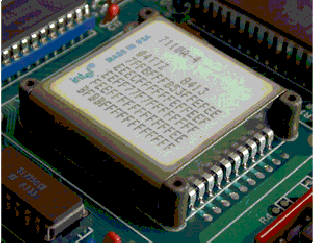magnetic bubble memory (MBM)
Magnetic bubble memory (MBM) was developed in the early 1980s and replaced by battery-buffered CMOS RAMs a few years later. It is a non-volatile memory that retains its stored data in the event of a power failure.
As storage elements, the bubble memory uses tiny cylindrical magnetic bubbles located in a thin film of magnetic material. The axes of the bubble cylinders are perpendicular to the surface. If a bubble is present, this is interpreted as a logic "1"; if none is present, this corresponds to logic "0". The bubbles are generated by a bubble generator, which converts an electrical signal accordingly. The bubble information is read out by an internal detector.
The bubble memory is a stationary memory in which the bubbles are guided in the desired direction by an externally applied magnetic field that changes continuously. Comparable to a shift register, the bubbles move in a closed loop due to the external magnetic field.
The storage density of magnetic bubble memories is around 10,000 storage cells per square millimeter, the bubble diameter is 5 micrometers and the access time is 500 microseconds.

